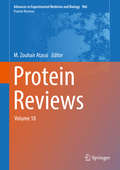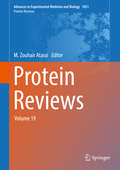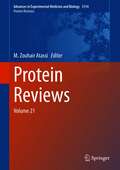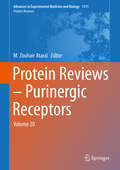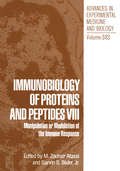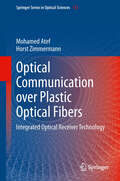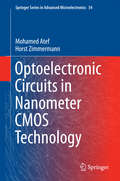- Table View
- List View
Islam’s Marriage with Neoliberalism: State Transformation in Turkey
by Y. AtasoyThe transformation of the Turkish state is examined here in the context of globalized frames of neo-liberal capitalism and contemporary schemas of Islamic politics. It shows how the historical emergence of two distinct yet intertwined imaginaries of state structuring, laiklik and Islam, continues to influence Turkish politics today.
Unsteady Aerodynamics, Aeroacoustics, and Aeroelasticity of Turbomachines and Propellers
by H. M. AtassiThe first International Symposium on Unsteady Aerodynamics and Aero elasticity of Turbomachines was held in Paris in 1976, and was followed by symposia at Lausanne in 1980, Cambridge in 1984, Aachen in 1987, Bei jing in 1989, and Notre Dame in 1991. The proceedings published following these symposia have become recognized both as basic reference texts in the subject area and as useful guides to progress in the field. It is hoped that this volume, which represents the proceedings of the Sixth International Symposium on Unsteady Aerodynamics of Turbomachines, will continue that tradition. Interest in the unsteady aerodynamics, aeroacoustics, and aeroelasticity of turbomachines has been growing rapidly since the Paris symposium. This expanded interest is reflected by a significant increase in the numbers of contributed papers and symposium participants. The timeliness of the topics has always been an essential objective of these symposia. Another important objective is to promote an international exchange between scien tists and engineers from universities, government agencies, and industry on the fascinating phenomena of unsteady turbomachine flows and how they affect the aeroelastic stability of the blading system and cause the radiation of unwanted noise. This exchange acts as a catalyst for the development of new analytical and numerical models along with carefully designed ex periments to help understand the behavior of such systems and to develop predictive tools for engineering applications.
Immunobiology of Proteins and Peptides-III: Viral and Bacterial Antigens (Advances in Experimental Medicine and Biology #185)
by M. Z. AtassiThis symposia series, founded in 1976, is devoted to the advancement and dissemination of knowledge in the field in immunology, particularly as it relates to the immune recognition and responses to protein and peptide antigens. Leading investigators are convened every 2 or 3 years for the purpose of consolidating the research on protein and peptide antigens of defined structure and to focus on these findings in the context of contemporary immunology. Each symposium has focussed on a particular aspect of molecular and cellular immunology of proteins and peptides. It is extremely gratifying that, in the last 2-3 years, the scientific community has shown a heightened interest in the study and understanding of protein and peptide antigens. The third symposium was devoted to viral and bacterial antigens. Great advances have been made in recent years in the elucidation and synthesis of protein antigenic sites. These, together with advances in cloning, expression and sequencing of protein genes, have offered new avenues for the preparation of synthetic vaccines for viral, bacterial and other antigens. Such vaccines have been the aspiration of immunologists for over 20 years. The meeting has served to integrate and correlate the current knowledge of these systems with developing trends in immunology and to identify the most promising new directions for future investigations.
Immunobiology of Proteins and Peptides VI: Human Immunodeficiency Virus, Antibody Immunoconjugates, Bacterial Vaccines, and Immunomodulators (Advances in Experimental Medicine and Biology #303)
by M. Zouhair AtassiThe articles in this volume represent papers delivered by invited speakers at the 6th International Symposium on the Immunobiology of Proteins and Peptides. In addition, a few of the abstracts submitted by participants were scheduled for minisymposia and some of the authors, whose presentations were judged by the Scientific Council to be of high quality, were invited to submit papers for publication in this volume. This symposium was established in 1976 for the purpose of bringing together, once every two or three years, active investigators in the forefront of contemporary immunology, to present their findings and discuss t heir significance in the light of current concepts and to identify important new directions of investigation. The founding of the symposium was stimulated by the achievement of major breakthroughs in the understanding of the immune recognition of proteins and peptides. We believed that these breakthroughs will lead to the creation of a new generation of peptide reagents which should have enormous potential in biological, therapeutic and basic applications. This anticipated explosion has in fact since occurred and many applications of these pep tides are now being realized.
Immunobiology of Proteins and Peptides VII: Unwanted Immune Responses (Advances in Experimental Medicine and Biology #347)
by M. Zouhair AtassiThe articles in this volume represent papers delivered by invited speakers at the 7th International Symposium on the Immunobiology of Proteins and Peptides. In addition, a few of the abstracts submitted by participants were scheduled for minisymposia and some of the authors, whose presentations were judged by the Scientific Council to be of high quality, were invited to submit papers for publication in this volume. This symposium was established in 1976 for the purpose of bringing together, once every two or three years, active investigators in the forefront of contemporary immunology, to present their findings and discuss their significance in the light of current concepts and to identify important new directions of investigation. The founding of the symposium was stimulated by the achievement of major breakthroughs in the understanding of the immune recognition of proteins and peptides. We believed that these breakthroughs will lead to the creation of a new generation of peptide reagents which should have enormous potential in biological, therapeutic, and basic applications. This anticipated explosion has in fact since occurred and many applications of these peptides are now being realized. The seventh symposium focused on immune responses that have undesirable effects on the host, hence we named them unwanted immune responses. Two major aspects of unwanted immune responses were discussed at the symposium: Allergy and Autoimmunity.
Protein Reviews: Volume 17 (Advances in Experimental Medicine and Biology #925)
by M. Zouhair AtassiThe aim of the Protein Reviews is to serve as a publication vehicle for review articles that focus on crucial current vigorous aspects of protein structure, function, evolution and genetics. Volume 17 of Protein Reviews is the beginning of a new publication format. The volumes will appear online before they are published in a printed book. Articles will be selected according to their importance to the understanding of biological systems, their relevance to the unravelling of issues associated with health and disease or their impact on scientific or technological advances and developments. The chapters in this volume are authored by experts in the field. They deal with aspects of structure and biological activity of selected proteins. Specific chapters deal with the aggregation of FET proteins (FUS, EWSR1, TAF15) as a pathological change in amyotrophic lateral sclerosis, structural changes fundamental to gating of the cystic fibrosis transmembrane conductance regulator anion channel pore, the dual roles for epithelial splicing regulatory proteins 1 (ESRP1) and 2 (ESRP2) in cancer progression, controlling autolysis during flagella insertion in Gram-negative bacteria, the regulation of skeletal muscle myoblast differentiation and the proliferation by pannexins, hyaluronidase and chondroitinase, factors that control mitotic spindle elongation, how secreted phospholipase A2 type IIA (sPLA2-IIA) activates integrins in an allosteric manner, the simple and unique allosteric machinery of Thermus caldophilus lactate dehydrogenase, and the reduction of chemically stable multibonds: Nitrogenase-like biosynthesis of tetrapyrroles. This volume is intended for research scientists, clinicians, physicians, and graduate students in fields of biochemistry, cell biology, molecular biology microbiology, immunology and genetics.
Protein Reviews: Volume 18 (Advances in Experimental Medicine and Biology #966)
by M. Zouhair AtassiThe aim of the Protein Reviews is to serve as a publication vehicle for review articles that focus on crucial current vigorous aspects of protein structure, function, evolution and genetics. The volumes will appear online before they are published in a printed book. Articles are selected according to their importance to the understanding of biological systems, their relevance to the unravelling of issues associated with health and disease or their impact on scientific or technological advances and developments. The chapters in volume 18 are authored by experts in the field. They deal with aspects of structure and/or biological activity of selected proteins. The chapters review current research of the following topics: the Mechanism of channel gating and regulation of the activity of calcium-activated chloride channel ANO1, Structure and function of the two-component cytotoxins of Staphylococcus aureus, Membrane Fusion and Infection involving the influenza virus hemagglutinin, The impact of arrhythmogenic mutations through the structural determination of the L-type voltage-gated calcium channel, Discussion of some open questions pertaining to histone post-translational modifications and nucleosome organization in transcriptional regulation, Regulation of the extracellular SERPINA5 (protein C inhibitor) penetration through cellular membranes, Coding of Class I and II aminoacyl-tRNA synthetases, Nephrin phosphorylation in diabetes and chronic kidney injury, The structure-forming juncture in oxidative protein folding and the events in the ER, The polyspecificity of anti-lipid antibodies and its relevance to the development of autoimmunity. This volume is intended for research scientists, clinicians, physicians and graduate students in the fields of biochemistry, cell biology, molecular biology, immunology and genetics.
Protein Reviews: Volume 19 (Advances in Experimental Medicine and Biology #1051)
by M. Zouhair AtassiThe aim of the Protein Reviews is to serve as a publication vehicle for review articles that focus on crucial current vigorous aspects of protein structure, function, evolution and genetics. The volumes will appear online before they are published in a printed book. Articles are selected according to their importance to the understanding of biological systems, their relevance to the unravelling of issues associated with health and disease or their impact on scientific or technological advances and developments. Volume 19 focusses on Purinergic receptors, also termed purinoceptors. These are plasma membrane proteins present in nearly all mammalian tissues. They participate in a number of cell functions that include proliferation and migration of neural stem cells, vascular reactivity, apoptosis and cytokine secretion and have been associated with learning and memory, feeding conduct, movement and sleep. They facilitate relaxation of smooth muscle of the gut in response to adenosine (P1 receptors) or ATP (P2 receptors). The chapters in this volume are authored by experts in the field. They deal with aspects of structure and biological activity of selected receptor proteins. The first chapter in this volume reviews the current research on the Mechanism of channel gating and regulation of the activity of calcium-activated chloride channel ANO1. This is followed by a chapter dealing with Structure and function of the two-component cytotoxins of Staphylococcus aureus and a chapter on Membrane Fusion and Infection involving the Influenza virus Hemagglutinin. The fourth chapter reviews the impact of arrhythmogenic mutations through the structural determination of the L-type voltage-gated calcium channel. Then there is a chapter that discusses some open questions pertaining to histone post-translational modifications and nucleosome organization in transcriptional regulation. The next chapter deals with regulation of the extracellular SERPINA5 (protein C inhibitor) penetration through cellular membranes. This is followed by a chapter on coding of Class I and II aminoacyl-tRNA synthetases; a chapter on regulation of nephrin phosphorylation in diabetes and chronic kidney injury and a chapter on The Structure-Forming Juncture in oxidative protein folding and the events in the ER. Finally the last chapter deals with the polyspecificity of anti-lipid antibodies and its relevance to the development of autoimmunity. This volume is intended for research scientists, clinicians, physicians and graduate students in the fields of biochemistry, cell biology, molecular biology, immunology and genetics.
Protein Reviews: Volume 21 (Advances in Experimental Medicine and Biology #21)
by M. Zouhair AtassiThe Protein Reviews series serves as a publication vehicle for reviews that focus on crucial contemporary and vital aspects of protein structure, function, evolution and genetics. Volumes are published online first, prior to publication in a printed book. Chapters are selected according to their importance to the understanding of biological systems, relevance to the unravelling of issues associated with health and disease, or impact on scientific or technological advances and developments. Volume 21 presents eight review chapters authored by experts in the related fields. The first chapter covers the enzyme squalene monooxygenase and lipid levels and its relevance in health and disease. Chapter two presents a systematic analysis of the structural and functional aspects of heteromeric solute carriers. The third chapter provides a review of the role of CI- in type IV collagen assembly, function, and disease, including future directions for studies. This is followed by a summary in chapter four about the recent progress on defining the roles of the Slit-Robo signaling in bone metabolism and the possible roles of the interaction between Robo and neural epidermal growth factor-like proteins. Chapter five discusses recent data about the evolutionary aspects on structural differences between humans and the nematode in relation to previous knowledge of core proteins and GAG-attachment sites in Chn and CS proteoglycans of C.elegans and humans. The sixth chapter summarizes the immunochemical character of the IGHV1-69-derived RFs and the recognition mechanism of the IGHV1-69-derived RFs. Chapter seven covers regulated alternative translocation and its role as an emerging mechanism to regulate transmembrane proteins. Finally, chapter eight reviews current progress on IL-36 protein and biology and novel investigative tools. This volume is intended for research scientists, clinicians, physicians and graduate students in the fields of biochemistry, cell biology, molecular biology, immunology and genetics.
Protein Reviews: Volume 22 (Advances in Experimental Medicine and Biology #1371)
by M. Zouhair AtassiThe Protein Reviews series serves as a publication vehicle for reviews that focus on crucial contemporary and vital aspects of protein structure, function, evolution and genetics. Volumes are published online first, prior to publication in a printed book. Chapters are selected according to their importance to the understanding of biological systems, relevance to the unravelling of issues associated with health and disease, or impact on scientific or technological advances and developments. Volume 22 presents six review chapters authored by experts in related fields. The first chapter covers carotenoid-protein interactions. Chapter two addresses the non-continuum of eukaryotic transcriptional regulation. The third chapter reviews the structure of the regulatory and catalytic domains of the photoreceptor phosphodiesterase (PDE6) holoenzyme. Chapter four reviews the current knowledge on small molecule compounds that have been evaluated as rhodopsin modulators to be considered as leads for the development of novel therapies for retinitis pigmentosa. Chapter five deals with Plasticity-associated functionality and inhibition of the HIV protease. Finally, chapter six covers single-run catalysis and kinetic control of human telomerase holoenzyme. This volume is intended for research scientists, clinicians, physicians and graduate students in the fields of biochemistry, cell biology, molecular biology, immunology and genetics.
Protein Reviews: Volume 23 (Advances in Experimental Medicine and Biology #1414)
by M. Zouhair AtassiThe Protein Reviews series serves as a publication vehicle for reviews that focus on crucial contemporary and vital aspects of protein structure, function, evolution and genetics. Volumes are published online first, prior to publication in a printed book. Chapters are selected according to their importance to the understanding of biological systems, relevance to the unravelling of issues associated with health and disease, or impact on scientific or technological advances and developments. Volume 23 presents four review chapters authored by experts in related fields. The first chapter covers the structure and function of SNM1 family nucleases. Chapter two examines the molecular details of DNA integration by CRISPR-associated (Cas) proteins during adaptation in bacteria and archaea. The third chapter reviews the ordered motions in the nitric-oxide dioxygenase (NOD) mechanism of flavohemoglobin and assorted globins with tightly coupled reductases. Chapter four reviews structural analyses of the multicopper site of CopG support a role as a redox enzyme. This volume is intended for research scientists, clinicians, physicians and graduate students in the fields of biochemistry, cell biology, molecular biology, immunology and genetics.
Protein Reviews – Purinergic Receptors: Volume 20 (Advances in Experimental Medicine and Biology #1111)
by M. Zouhair AtassiThe Protein Reviews series serves as a publication vehicle for reviews that focus on crucial contemporary and vital aspects of protein structure, function, evolution and genetics. Volume 20, Purinergic Receptors, has ten chapters. The first five chapters deal with various aspects of membrane binding. The first chapter focuses on the phox-homology (PX) domain, which is a phosphoinositide-binding domain conserved in all eukaryotes and present in forty-nine human proteins. The next chapter deals with the modeling of PH domains/phosphoinositides interactions. This is followed by a chapter on BAR domain proteins regulate Rho GTPase signaling. The BAR (Bin–Amphiphysin–Rvs) domain is a membrane lipid binding domain present in a wide variety of proteins, often proteins with a role in Rho-regulated signaling pathways. The fourth article presents AP180 N-terminal homology (ANTH) and Epsin N-terminal homology (ENTH) domains and discusses their physiological functions and involvement in disease. The fifth article reviews the polyphosphoinositide-binding domains and presents insights from peripheral membrane and lipid-transfer proteins. This is followed by a chapter on the physiological functions of phosphoinositide-modifying enzymes and their interacting proteins in Arabidopsis, then by a chapter on the molecular mechanisms of Vaspin action in various tissues such as adipose tissue, skin, bone, blood vessels, and the brain. The eighth chapter deals with exceptionally selective substrate targeting by the metalloprotease anthrax lethal factor followed by an article on Salmonella, E. coli, and Citrobacter type III secretion system effector proteins that alter host innate immunity. The last chapter presents New techniques to study intracellular receptors in living cells, with insights into RIG-I-like receptor signaling. Volume 20 is intended for research scientists, clinicians, physicians and graduate students in the fields of biochemistry, cell biology, molecular biology, immunology and genetics.
Methods in Protein Structure Analysis
by M. Zouhair Atassi Ettore AppellaThe MPSA international conference is held in a different country every two years. It is devoted to methods of determining protein structure with emphasis on chemistry and sequence analysis. Until the ninth conference, MPSA was an acronym for Methods in Protein Sequence Analysis. To give the conference more flexibility and breadth, the Scientific Advisory Committee of the lOth MPSA decided to change the name to Methods in Protein Structure Analysis; however, the emphasis remains on "methods" and on "chemistry. " In fact, this is the only major conference that is devoted to methods. The MPSA conference is truly international, a fact clearly reflected by the composi tion of its Scientific Advisory Committee. The Scientific Advisory Committee oversees the scientific direction of the MPSA and elects the chairman of the conference. Members of the committee are elected by active members, based on scientific standing and activity. The chairman, subject to approval of the Scientific Advisory Committee, appoints the Organizing Committee. It is this latter committee that puts the conference together. The lectures of the MPSA have traditionally been published in a special proceedings issue. This is different from, and more detailed than, the special MPSA issue of the Journal of Protein Chemistry in which only a brief description of the talks is given in short papers and abstracts. In the I Oth MPSA, about half the talks are by invited speakers and the remainder were selected from submitted short papers and abstracts.
Immunobiology of Proteins and Peptides VIII: Manipulation or Modulation of the Immune Response (Advances in Experimental Medicine and Biology #383)
by M. Zouhair Atassi Garvin S. BixlerThis volume summarizes the proceedings of the Eighth International Symposium on the Immunobiology of Proteins and Peptides which was held on November 16-20 in Rio Rico, Arizona. The articles represent papers by invited speakers as well as papers selected by the Scientific Council, from among those submitted by the participants, on the basis of quality and timeliness. This symposium series was established in 1976 for the purpose of bringing together, once every two or three years, active investigators in the forefront of contemporary immunology, to present their findings, discuss their significance in the light of current concepts and identify important new directions of investigation. The founding of the symposium was stimulated by the achievement of major breakthroughs in the understanding of the immune recognition of proteins and peptides. We believed that these breakthroughs would lead to the creation of a new generation of peptide reagents, which could have enormous potential in biological, therapeutic, and basic applications. This anticipated explosion has since occurred and many applications ofthese peptides are now being realized. The eighth symposium focused on the manipulation or modulation of the immune response. This volume broadly covers the areas of adjuvants, cytokines, vaccines, and the use of intravenous immunoglobulins for disease management. There is a clear need to identify methods for improving vaccine efficacy and guiding the host to respond with a particular type of immune response.
Complex Time-Delay Systems: Theory and Applications (Understanding Complex Systems)
by Fatihcan M. AtayOne of the major contemporary challenges in both physical and social sciences is modeling, analyzing, and understanding the self-organization, evolution, behavior, and eventual decay of complex dynamical systems ranging from cell assemblies to the human brain to animal societies. The multi-faceted problems in this domain require a wide range of methods from various scienti?c disciplines. There is no question that the inclusion of time delays in complex system models considerably enriches the challenges presented by the problems. Although this inclusion often becomes inevitable as real-world applications demand more and more realistic m- els, the role of time delays in the context of complex systems so far has not attracted the interest it deserves. The present volume is an attempt toward ?lling this gap. There exist various useful tools for the study of complex time-delay systems. At the forefront is the mathematical theory of delay equations, a relatively mature ?eld in many aspects, which provides some powerful techniques for analytical inquiries, along with some other tools from statistical physics, graph theory, computer science, dynamical systems theory, probability theory, simulation and optimization software, and so on. Nevertheless, the use of these methods requires a certain synergy to address complex systems problems, especially in the presence of time delays.
Optics of the Human Eye (Multidisciplinary and Applied Optics)
by David A. AtchisonThis book describes the optical structure and optical properties of the human eye. For ease of reference, the most commonly useful topics are at the beginning and topics with narrower appeal are placed towards the end. The book is divided into five sections, covering: Basic optical structure of the eye, including the refracting components, the pupil, axes, and simple models of the eye Image formation and refraction of the eye, including refractive errors, measurement, and correction Interactions between light and the eye, considering transmission, reflection, and scatter in the media and at the fundus Aberrations and retinal image quality Depth-of-field and age-related changes in the optics of the eye There have been many developments in the field of visual optics since the first edition was published in 2000. There have been advances in instrumentation for imagery, biometry, and aberrations of the eye. The refraction anomaly of myopia has increased in prevalence throughout the world, and is getting increasing attention because of its association with ocular pathology in the middle and later years of life. Ocular aberrations are now considered in terms of Zernike polynomials rather than Taylor polynomials. Aberrations can be manipulated to better understand their effects on visual performance to improve imagery of the retina for the betterment of diagnosis of various ocular conditions, and to treat the progression of myopia in children. To deal with these developments, the section on aberrations and retinal image quality has undergone considerable revision. This book will be an invaluable purchase for all those with an interest in vision, such as optometrists, ophthalmologists, vision scientists, optical physics, and student of visual optics. An understanding of the optics of the human eye is particular important to designers of ophthalmic diagnostic equipment and visual optical systems such as telescopes.
Optics of the Human Eye (Multidisciplinary and Applied Optics)
by David A. AtchisonThis book describes the optical structure and optical properties of the human eye. For ease of reference, the most commonly useful topics are at the beginning and topics with narrower appeal are placed towards the end. The book is divided into five sections, covering: Basic optical structure of the eye, including the refracting components, the pupil, axes, and simple models of the eye Image formation and refraction of the eye, including refractive errors, measurement, and correction Interactions between light and the eye, considering transmission, reflection, and scatter in the media and at the fundus Aberrations and retinal image quality Depth-of-field and age-related changes in the optics of the eye There have been many developments in the field of visual optics since the first edition was published in 2000. There have been advances in instrumentation for imagery, biometry, and aberrations of the eye. The refraction anomaly of myopia has increased in prevalence throughout the world, and is getting increasing attention because of its association with ocular pathology in the middle and later years of life. Ocular aberrations are now considered in terms of Zernike polynomials rather than Taylor polynomials. Aberrations can be manipulated to better understand their effects on visual performance to improve imagery of the retina for the betterment of diagnosis of various ocular conditions, and to treat the progression of myopia in children. To deal with these developments, the section on aberrations and retinal image quality has undergone considerable revision. This book will be an invaluable purchase for all those with an interest in vision, such as optometrists, ophthalmologists, vision scientists, optical physics, and student of visual optics. An understanding of the optics of the human eye is particular important to designers of ophthalmic diagnostic equipment and visual optical systems such as telescopes.
Optical Communication over Plastic Optical Fibers: Integrated Optical Receiver Technology (Springer Series in Optical Sciences #172)
by Mohamed Atef Horst ZimmermannThis book presents high-performance data transmission over plastic optical fibers (POF) using integrated optical receivers having good properties with multilevel modulation, i.e. a higher sensitivity and higher data rate transmission over a longer plastic optical fiber length. Integrated optical receivers and transmitters with high linearity are introduced for multilevel communication. For binary high-data rate transmission over plastic optical fibers, an innovative receiver containing an equalizer is described leading also to a high performance of a plastic optical fiber link. The cheap standard PMMA SI-POF (step-index plastic optical fiber) has the lowest bandwidth and the highest attenuation among multimode fibers. This small bandwidth limits the maximum data rate which can be transmitted through plastic optical fibers. To overcome the problem of the plastic optical fibers high transmission loss, very sensitive receivers must be used to increase the transmitted length over POF. The plastic optical fiber limited bandwidth problem can be decreased by using multilevel signaling like multilevel pulse amplitude modulation or by using an equalizer for binary data transmission.
Optoelectronic Circuits in Nanometer CMOS Technology (Springer Series in Advanced Microelectronics #55)
by Mohamed Atef Horst ZimmermannThis book describes the newest implementations of integrated photodiodes fabricated in nanometer standard CMOS technologies. It also includes the required fundamentals, the state-of-the-art, and the design of high-performance laser drivers, transimpedance amplifiers, equalizers, and limiting amplifiers fabricated in nanometer CMOS technologies. This book shows the newest results for the performance of integrated optical receivers, laser drivers, modulator drivers and optical sensors in nanometer standard CMOS technologies. Nanometer CMOS technologies rapidly advanced, enabling the implementation of integrated optical receivers for high data rates of several Giga-bits per second and of high-pixel count optical imagers and sensors. In particular, low cost silicon CMOS optoelectronic integrated circuits became very attractive because they can be extensively applied to short-distance optical communications, such as local area network, chip-to-chip and board-to-board interconnects as well as to imaging and medical sensors.
Sensory Processing in Aquatic Environments
by J. Atema N. Justin Marshall R. R. Fay A. N. Popper W. N. Tavolga Shaun P. Collin T. BullockResearch on sensory processing or the way animals see, hear, smell, taste, feel and electrically and magnetically sense their environment has advanced a great deal over the last fifteen years. This book discusses the most important themes that have emerged from recent research and provides a summary of likely future directions. The book starts with two sections on the detection of sensory signals over long and short ranges by aquatic animals, covering the topics of navigation, communication, and finding food and other localized sources. The next section, the co-evolution of signal and sense, deals with how animals decide whether the source is prey, predator or mate by utilizing receptors that have evolved to take full advantage of the acoustical properties of the signal. Organisms living in the deep-sea environment have also received a lot of recent attention, so the next section deals with visual adaptations to limited light environments where sunlight is replaced by bioluminescence and the visual system has undergone changes to optimize light capture and sensitivity. The last section on central co-ordination of sensory systems covers how signals are processed and filtered for use by the animal. This book will be essential reading for all researchers and graduate students interested in sensory systems.
Estuarine and Wetland Processes: With Emphasis on Modeling (Marine Science #11)
by Keith B. Ater P. MacdonaldEstuaries and Wetlands are important coastal resources which are subject to a great deal of environmental stress. Dredging, construction, creation of intertidal wetlands, regulation of fresh water flow, and pollution are just a few of the activities which affect these coastal systems. The need to predict the effects of these perturbations upon ecosystem dynamics, particularly estuarine fisheries, as well as on physical effects, such as sedimentation and salt intrusion, is of paramount importance. Prediction requires the use of models, but no model is likely to be satisfactory unless fundamental physical, chemical, sedimentological, and biological processes are quantitatively understood, and the appropriate time and space scales known. With these considerations in mind, the Environmental Laboratory, U. S. Army Engineer Haterways Experiment Station,* Vicksburg, Mississippi, sponsored a workshop on "Estuarine and Wetland Processes and Water Quality Modeling" held in New Orleans, June 1979. The contents of this volume have been selected from the workshop papers. The resulting book, perhaps more than any other symposium proceed ings on estuaries and wetlands, attempts to review important pro cesses and place them in a modeling context. There is also a distinct applied tinge to a number of the contributions since some of the research studies were motivated by environmental assessments. The difference in title between this volume and the workshop re flects more accurately the contents of the published papers.
Inclusive Green Growth: Challenges and Opportunities for Green Business in Rural Africa (Advances in African Economic, Social and Political Development)
by Calvin Atewamba Dorothé Yong NgondjebFostering inclusive green growth in Africa means addressing existing and emerging development challenges, while efficiently managing Africa’s natural capital and building resilience to environmental, social and economic risks. Although this new paradigm for development has the potential to create tremendous business opportunities, there are also challenges. This book provides empirical evidence on the conditions for the emergence of green businesses in Africa. It includes 13 case studies, which identify the determinants of small and medium-size enterprises’ engagement in inclusive and sustainable growth in rural Africa, and the factors that hinder eco-innovation in business and entrepreneurial activities. Furthermore it discusses appropriate regulations and policies to stimulate the development of green business in Africa. Offering insights into the relationship between eco-innovation, labor productivity and business competitiveness in rural Africa, this book appeals to scholars, policy makers and practitioners interested in a green economy for Africa.
Advances in Petroleum Source Rock Characterizations: A Multidisciplinary Source Rock Approach (Advances in Science, Technology & Innovation)
by Haytham El Atfy Bandar I. GhassalThis book is directed to those who are interested in petroleum geology, especially source rock from both academia and industrial societies. Our chapter-based book is written by a list of world-class subject-matter experts.The book includes recent advancements in analytical source rock characterization methods with some case studies. It is also used as part of a course curriculum or guide for source rock interpretation for all researcher categories.Significant improvement in the source rock characterization techniques in the last two decades and the knowledge is disseminated in a huge amount of papers and studies. The book intends to collect these recent advancements in one textbook to benefit students and researchers in general. In addition, it is supplemented by many case studies from all over the world that represent important data sets for the regional geology of these areas.
Articular Cartilage
by Kyriacos A. Athanasiou Eric M. Darling Jerry C. Hu Grayson D. DuRaine A. Hari ReddiThis book covers the latest research and advancements related to articular cartilage in biology, development, pathology, clinical applications and tissue engineering. The authors take an interdisciplinary approach that encompasses the breadth and depth of basic science, bioengineering, translational science and detailed methological approaches. It is designed to be an all encompassing encyclopedia of articular cartilage. Written at a level that allows wide accessibility, the book’s comprehensive focus on multiple aspects of articular cartilage sets it apart from other books.
Articular Cartilage (Synthesis Lectures On Tissue Engineering Ser.)
by Kyriacos A. Athanasiou Eric M. Darling Jerry C. Hu Grayson D. DuRaine A. Hari ReddiThis book covers the latest research and advancements related to articular cartilage in biology, development, pathology, clinical applications and tissue engineering. The authors take an interdisciplinary approach that encompasses the breadth and depth of basic science, bioengineering, translational science and detailed methological approaches. It is designed to be an all encompassing encyclopedia of articular cartilage. Written at a level that allows wide accessibility, the book’s comprehensive focus on multiple aspects of articular cartilage sets it apart from other books.

